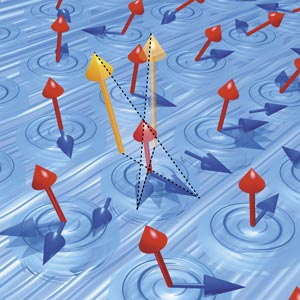Aug. 19, 2016 Research Highlight Physics / Astronomy
A changed exchange for magnetic materials
A method for controlling the magnetic texture of exotic materials offers a route to realizing the next generation of electronic devices
 Figure 1: Exchange interactions between spins (indicated by arrows) lead to magnetic textures that can be used for information processing. © 2016 Mari Ishida, RIKEN Center for Emergent Matter Science
Figure 1: Exchange interactions between spins (indicated by arrows) lead to magnetic textures that can be used for information processing. © 2016 Mari Ishida, RIKEN Center for Emergent Matter Science
A model for understanding why unusual magnetic structures such as vortices arise in some materials has been developed by RIKEN researchers1. This model could help with the design of electronic devices offering lower energy consumptions.
Magnetism arises because of an electron property known as spin, which makes the electrons behave like tiny magnets. In a typical magnet, these spins align in a uniform direction due to an interaction between them called a symmetric exchange interaction.
On the other hand, an antisymmetric exchange interaction, known as the Dzyaloshinskii–Moriya interaction, causes adjacent spins to misalign slightly. This interaction leads to magnetic patterns that are much more complex than simple parallel ordering, such as magnetic vortices and helices.
Scientists are investigating these unusual magnetic textures as a route to spin-based information processing. However, a better understanding of how the Dzyaloshinskii–Moriya interaction arises, and methods for predicting its strength are needed to aid the development of better spintronic materials and devices that require much less power than conventional electronic devices.
“The Dzyaloshinskii–Moriya interaction has been known for more than half a century,” says RIKEN scientist Toru Kikuchi. “But previous studies on its microscopic origin merely reported calculation results without presenting a physical picture of how it actually works.”
Kikuchi and his co-workers from the RIKEN Center for Emergent Matter Science provide a more visual understanding of the interaction. They show that the Dzyaloshinskii–Moriya interaction arises because of a Doppler effect due to an intrinsic spin current: in certain kinds of magnets, a spin current is induced intrinsically without any external forces, and this intrinsic spin current modifies the propagation of exchange interactions between spins. A similar effect can be observed in the way the wind modifies the propagation of sound waves.
The researchers show, moreover, that the strength of the Dzyaloshinskii–Moriya interaction is equal to the magnitude of the intrinsic spin current.
Kikuchi and his co-workers used this insight to develop first-principles calculations for predicting the strength of the Dzyaloshinskii–Moriya interaction. The results they obtained agreed strongly with previous experimental values for alloys of manganese iron germanium and iron cobalt germanium.
“Our picture indicates the possibility of controlling the Dzyaloshinskii–Moriya interaction using the spin current,” says Kikuchi. “This may open up a new way to create novel devices.”
Related contents
- Evidence for stable room-temperature skyrmions
- Manipulating the texture of magnetism
- Magnetic vortices with electric sense
References
- 1. Kikuchi, T., Koretsune, T., Arita, R. & Tatara, G. Dzyaloshinskii-Moriya interaction as a consequence of a Doppler shift due to spin-orbit-induced intrinsic spin current. Physical Review Letters 116, 247201 (2016). doi: 10.1103/PhysRevLett.116.247201
